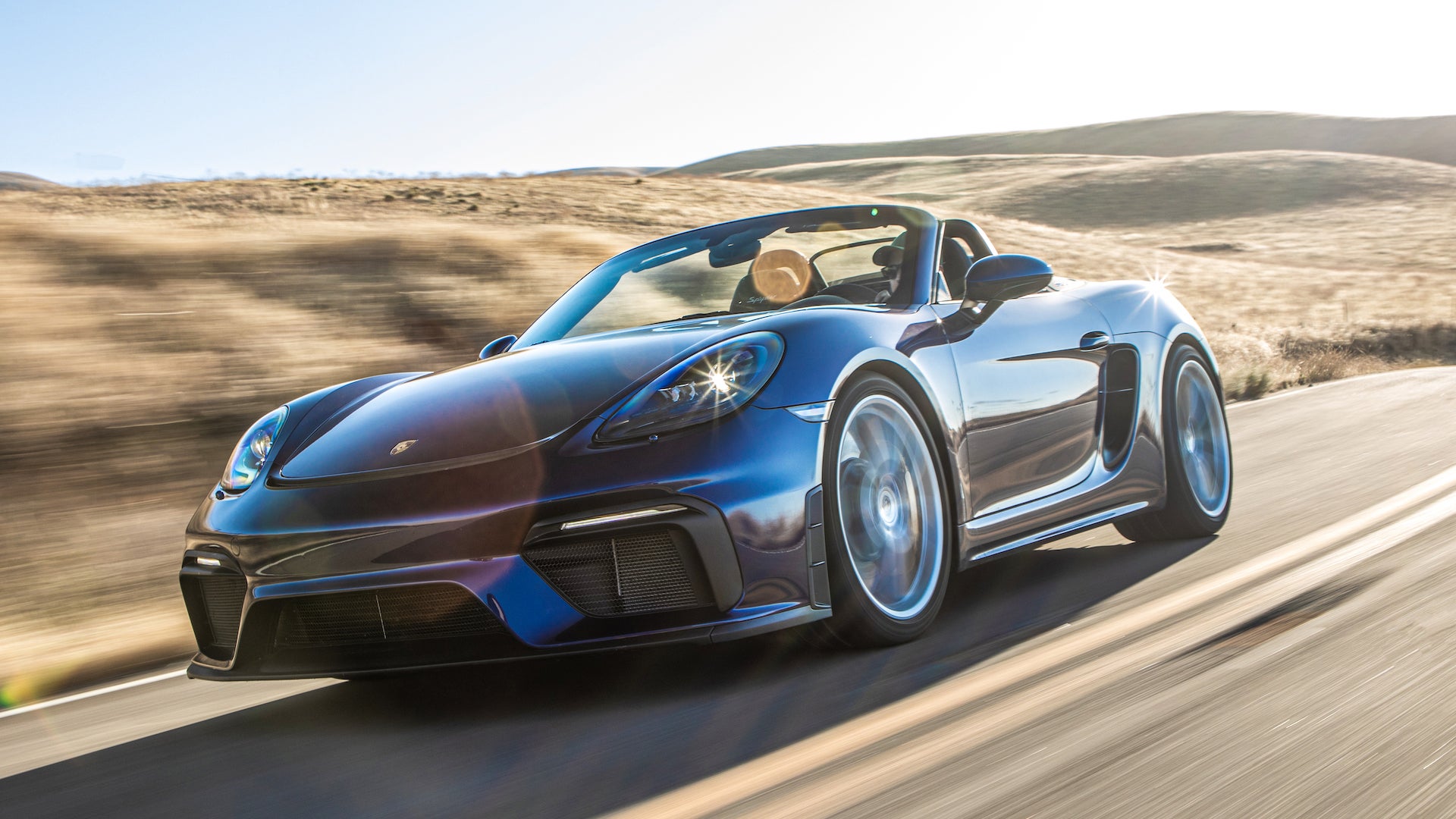Once, the Porsche Boxster Spyder and Cayman GT4 were separate beasts: The GT4, a sharp, hard-edged coupe tuned by Porsche’s Motorsport’s GT wonks, the Spyder, an elemental version of Porsche's roadster with close ties to the Boxster GTS. Both cars shared a 3.8-liter six from the 911 Carrera S, the Spyder muddling through with 10 fewer horses than the GT4. From there, the paths diverged.
The GT4’s mods—front suspension from the 911 GT3, a lighter strut setup and ball joints in the rear, and downforce aero—destined it for serious racetrack play, while the Spyder’s mild lightweighting strategy italicized its road-car performance. Nonetheless, each pushed the sensory range of Porsche’s mid-engine platform in its own way, and both were fantastic to drive. But now the Spyder gets the same cool GT stuff, putting the two cars in parity for the first time. How'd that work out?
The 2020 Porsche 718 Spyder, By the Numbers
- Base Price (as tested): $96,300 ($120,530; includes +$1,350 delivery)
- Powertrain: 4.0-liter flat six | 6-speed manual transmission | rear-wheel drive
- Horsepower: 410 hp @ 7,600 RPM
- Torque: 309 lb-ft @ 5,000-6,800 RPM
- 0-60 mph: 4.4 seconds
- Top Speed: 186 mph
- Weight Distribution: 44% (front) | 56% (rear)
- Curb Weight: 3,206 lbs
- Quick Take: A no-compromise roadster combining a traditional top-down experience with out-and-out performance and modern tech.
Praise be to Weissach, the Spyder and GT4 are now in alignment. Both cars benefit from development work by Porsche’s GT squad, which turns out such motorsport-leavened 911 variants as the GT2 and GT3 RS. The newest Boxster’s platform rigidity helped make the case for a full GT once-over, and that’s welcome news for those who prefer to do their driving under the ol' wheel in the sky.
California’s Route 33 lays like a party streamer across the Los Padres National Forest, throwing off great arcs of cambered pavement from Ojai to the Central Valley’s doorstep. It's a self-evident venue for cars like the Spyder. Here, the golden sunlight and occasional noseful of eucalyptus only enhance the Spyder’s shimmering waves of torque, instant throttle response, and exquisite chassis balance. A familiar flat-six buzz-roar pings off the canyon walls and into the cockpit like a thousand carbon-fiber cellos pounding out "Enter Sandman." It makes for a helluva day of driving, if you’re into that sort of thing.
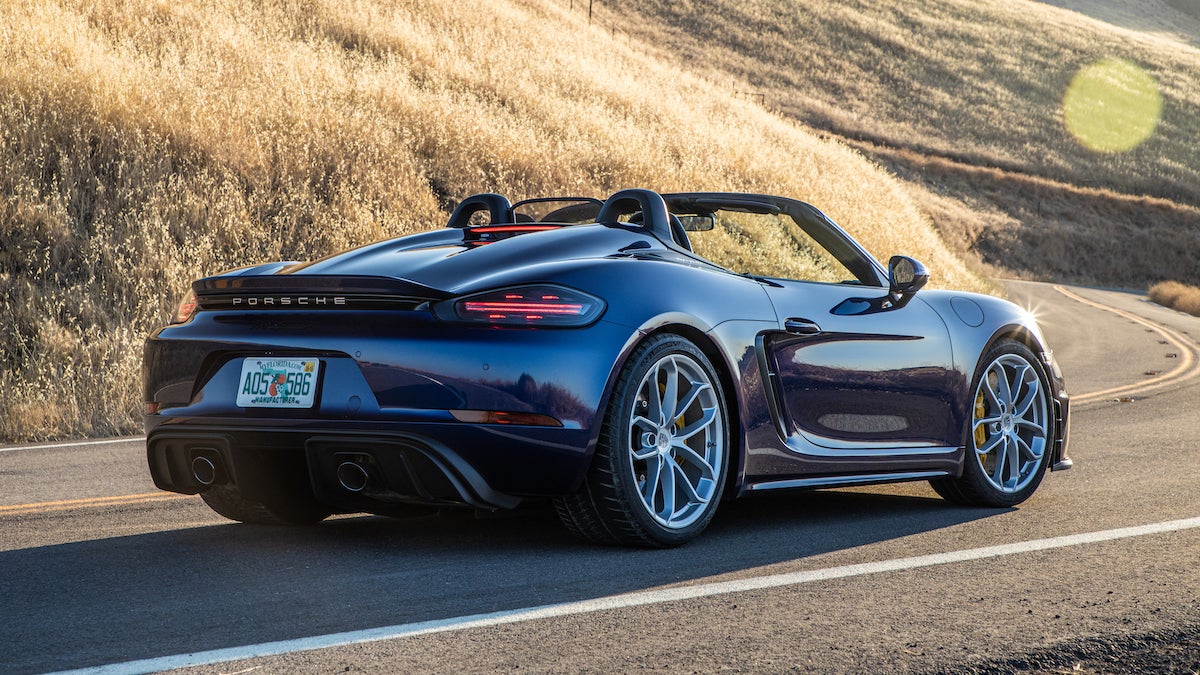
Like the previous, 981-series cars, the new GT4 and Spyder get identical, naturally-aspirated engines. This one's a 414-hp take on the 9A2 flat six from the 992.2 Carrera, so thoroughly worked-over it should have its own birthday. The GT team removed the turbos, tweaked displacement from 3.0 liters to 4.0 liters (increasing bore and stroke), and pored over it from the bottom up, loading in a new crank, conrods, and pistons, topping it off with new heads and valvetrain.
Those internals permit a joyful crescendo that peaks at an 8,000-rpm redline; 500 more than the 992 Carrera S, and only 1,000 less than the 911 GT3, whose own four-liter rager would have been too costly and complex for Spyder duty. Torque output peaks at 5,000-6,800 rpm, a thrilling band of revs in both force and sound. Engineers dutifully added cylinder deactivation functionality at low torque loads (below ~73 lb-ft), when, with a low grumble, three cylinders cut out for an incremental boost in fuel economy.
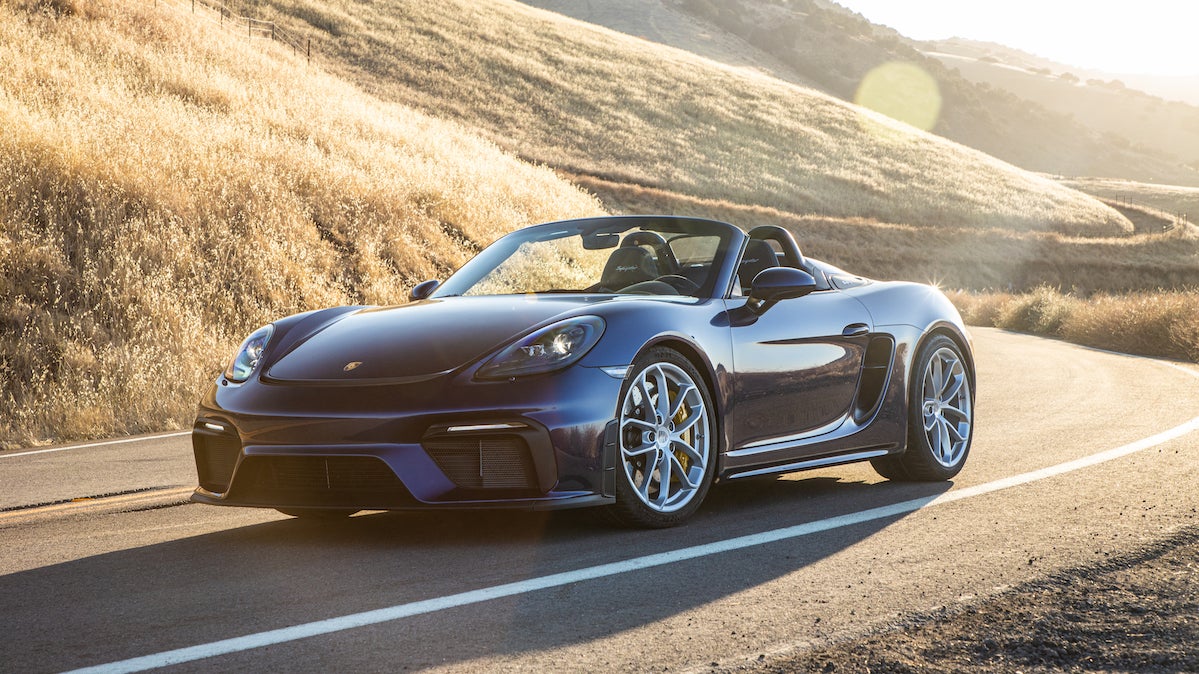
A six-speed manual is the only transmission choice, with a snub-nosed shift lever that fits in hand like a Zippo. The auto-blip rev matching function is clever, but can be turned off easily. Despite the usual, maddeningly tall gears—a necessity to meet emissions standards—it’s impossible not to keep this engine on boil, even if ripping around canyon roads in second gear—which touches 85 mph—can be like listening to the same guitar riff over and over again.
Indeed, this Spyder is fast. It pulls like a rocket sled from three grand up, and that feeling force-multiplies all the way to redline, bombarding the senses in a way that makes the numbers game irrelevant. Not that Spyder buyers will surrender much to their GT4-owning peers, with a zero-to-60 time on par with the GT4, at 4.2 seconds, and nine flat to 100 mph. The Spyder gives away a single mile per hour at top speed (186 to the GT4’s 187). Weight wise, the Spyder and GT4 enjoy similar same gravity pull: The Spyder at 3,206 pounds all in (the GT4 at 3,199).
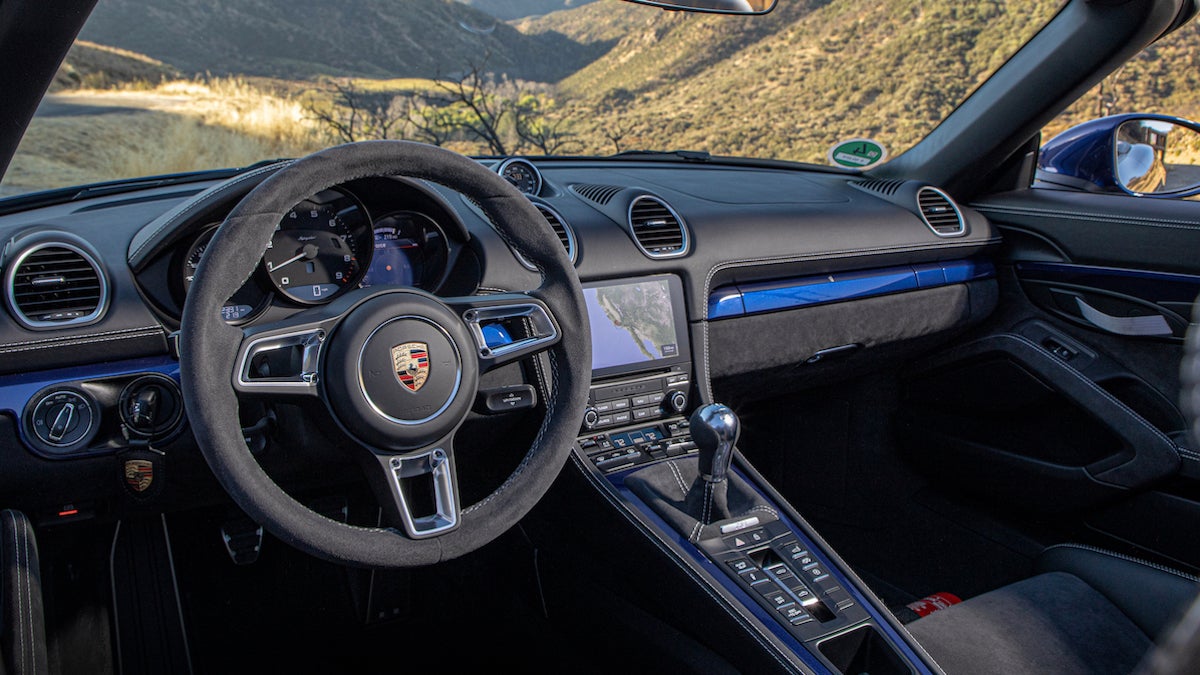
Dynamically, the Spyder’s sublime chassis benefits from the same hard-mount subframe, suspension, steering, and brakes as the GT4. Underneath, the chassis setups are also in parity, a 911 GT3-based front end and tuned, lighter-weight rear strut setup with smaller “helper springs” that pretension the lightweight main springs, holding them in place during full rebound. Porsche’s PASM sport active suspension comes standard, lowering ride height by 1.18 inches compared to a base Boxster and adding nuance the previous model’s single-stage dampers couldn’t muster.
The combination of mechanical LSD and brake-based torque vectoring continue to be the hot setup for accurate rotation in slow corners. The GT3’s cross-ventilated, 15” steel rotors surround both cars, providing immense stopping power, with optional carbon ceramics available for track rats.
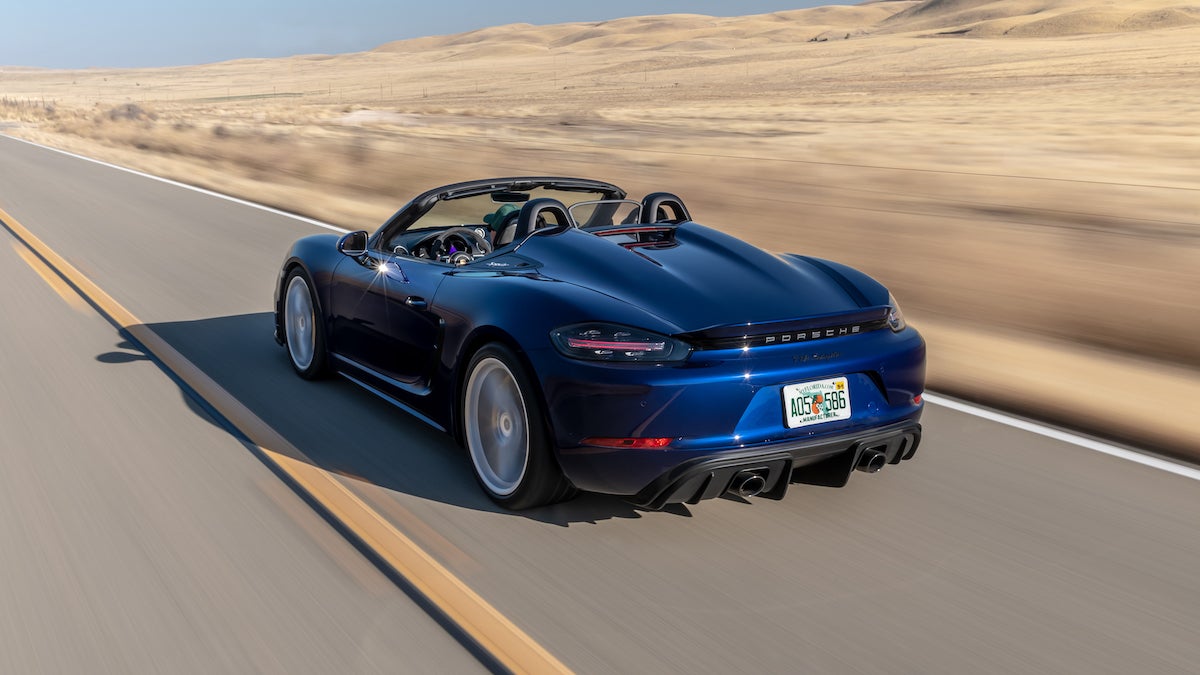
Visually, the Spyder matches the GT4 at the front and rear. A manual bikini top and double-bubble “streamliner” humps still sit, speedster-style, behind the Spyder’s head rests. The GT4’s rear wing is absent on the Spyder in favor of a far smaller rear wing that emerges at high speeds. Both employ identical underbody diffusers, netting the Spyder as “downforce neutral,” meaning its positive and negative lift are in balance at speed.
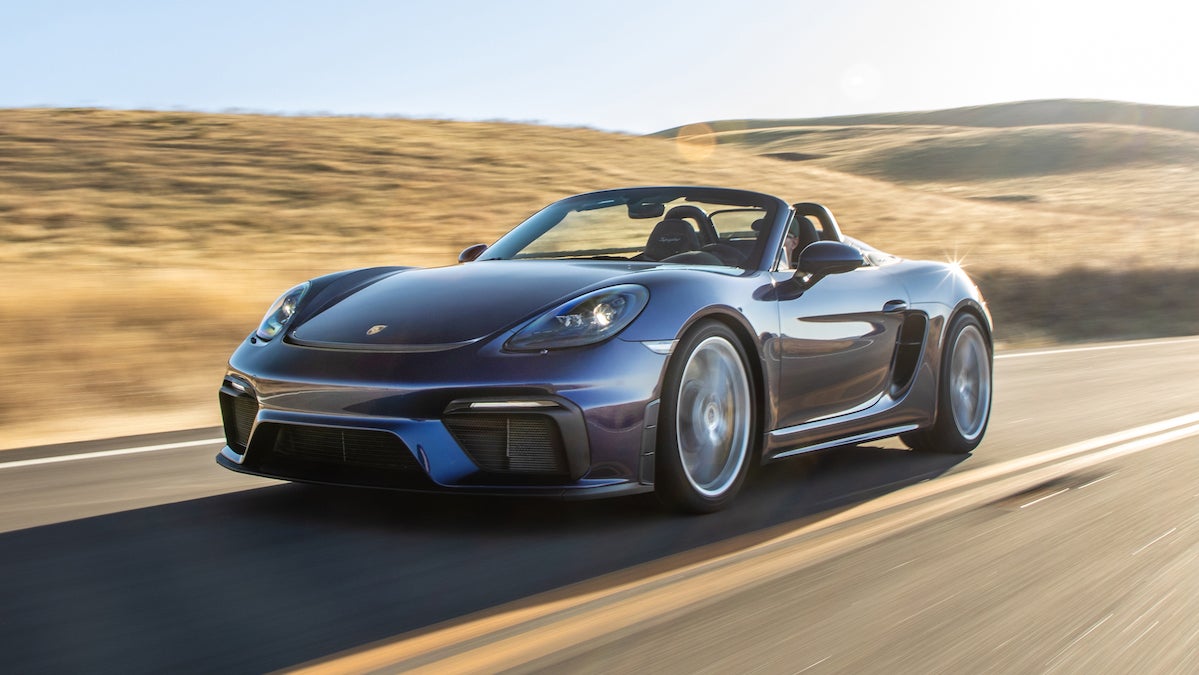
Out on the road, the updated chassis forms a sophisticated union of composure and feedback that controls sprung mass with amazing skill. Ride quality is firm, but not harsh. The Spyder begs to be flung headlong up and over Route 33's undulations and around its hairpins at any speed. The knife's-edge balance of Porsche's mid-engine platform is still unmatched in its class, and in this tune it's as close to perfect as Porsche has ever managed.
Whether at 50 mph or twice that, the Spyder triggers the senses to a degree not matched by any other modern sports car. It’s quick, feels wired to the topography of the road, and delivers every force acting on it instantly to the fingertips. The brakes feel overbuilt and rock solid. The communications between driver, car, and highway are direct and elegant. The Spyder could be the purest sports car built today, even if it takes cutting-edge technology to make it so.

